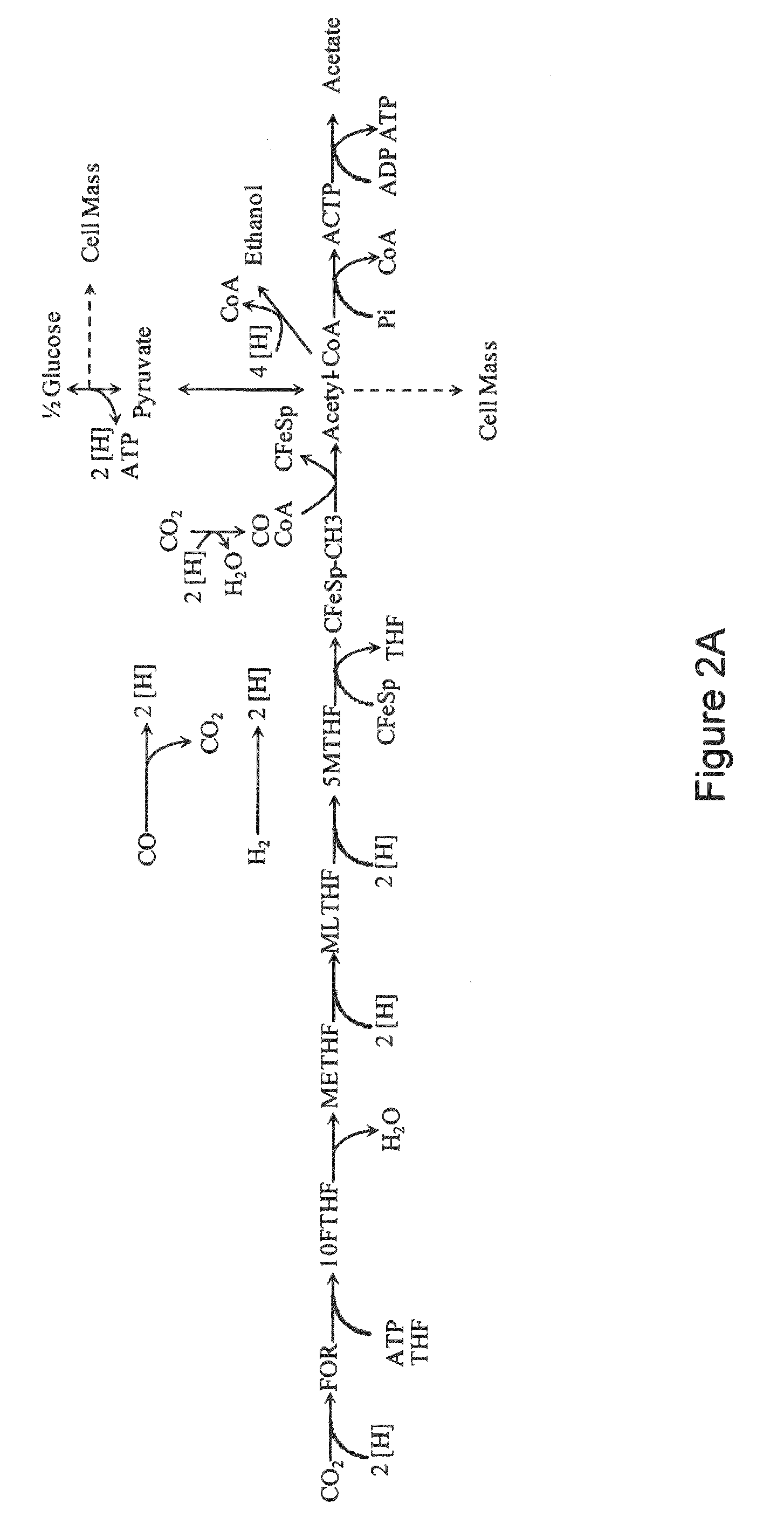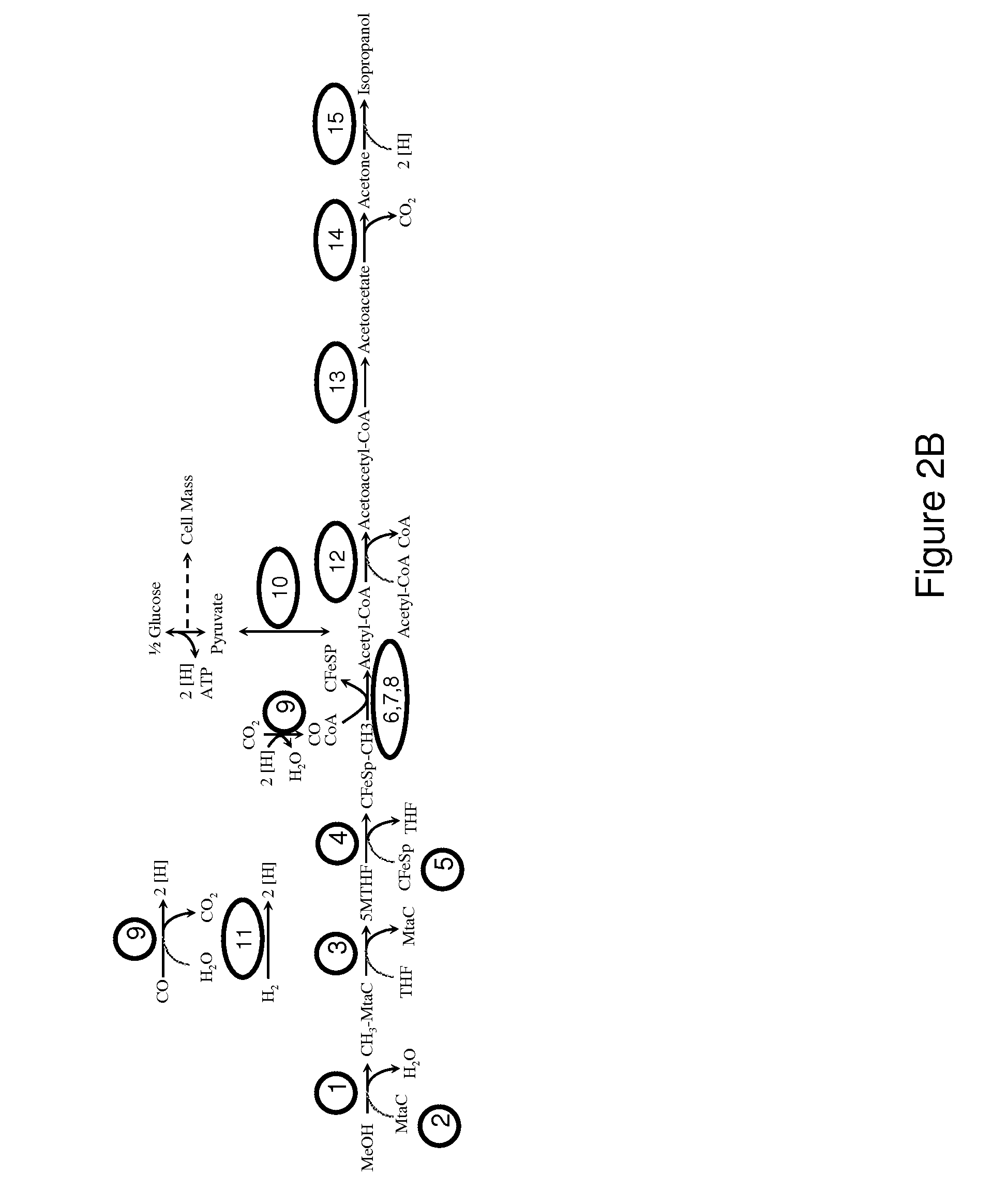Microorganisms and methods for conversion of syngas and other carbon sources to useful products
a technology of syngas and other carbon sources, applied in the field of biosynthetic processes and organisms, can solve the problems of limiting titers and commercialization potential, not being able to rapidly improve the yield or production characteristics of a desired product, and being poorly characterized by organisms
- Summary
- Abstract
- Description
- Claims
- Application Information
AI Technical Summary
Benefits of technology
Problems solved by technology
Method used
Image
Examples
example i
ACS / CODH Gene Insertions in E. coli
[0263]This example describes the creation of E. coli plasmids that express the M. thermoacetica ACS / CODH operon genes including those required for CODH, ACS, methyltransferase, and the corrinoid iron-sulfur protein. This example further describes the expression these in E. coli resulting in observable CO oxidation activity, methyltransferase activity, and corrinoid iron-sulfur protein activity. Finally, this example demonstrates that E. coli tolerates high CO concentrations, and may even consume CO when the CO-utilizing gene products from M. thermoacetica are expressed.
[0264]Expression vectors were chosen from the set described by Lutz and Bujard (Lutz and Bujard, Nucleic Acids Res. 25:1203-1210 (1997)); these come with compatible replicons that cover a range of copy numbers. Additionally, each contains prAl-lacol; this T7 early gene promoter is inducible by IPTG and can lead to very high levels of transcription in the presence of IPTG and repress...
example ii
Enhancing the Yield of Fermentation Products from Sugars with Wood-Ljungdahl Pathway Enzymes
[0284]In this example, we describe a non-naturally occurring microorganism expressing genes encoding enzymes that catalyze the carbonyl-branch of the Wood-Ljungdahl pathway. Wood-Ljungdahl pathway enzymes assimilate carbon in the form of CO and / or CO2 into acetyl-CoA, which can subsequently be converted to useful chemical products such as isopropanol, 4-hydroxybutyrate (4-HB) and 1,4-butanediol (14-BDO). The Wood-Ljungdahl pathway can also serve as a secondary carbon assimilation pathway during growth on other substrates such as glucose. In this capacity, WL pathway enzymes harness reducing equivalents generated in glycolysis to convert CO2 to acetyl-CoA, cell mass and downstream products at high yield.
[0285]Isopropanol: Engineering a Wood-Ljungdahl pathway into a glucose-utilizing and isopropanol-producing organism improves the maximum isopropanol yield up to 33%. The production of isopropan...
example iii
Enhancing the Yield of Fermentation Products from Sugars with Wood-Ljungdahl Pathway Enzymes and a MtaABC-Type Methyltransferase System
[0289]An organism engineered to express genes encoding an ACS / CODH enzyme and a MtaABC-type methyltransferase system is capable of producing acetyl-CoA and downstream products at high yields from glucose and methanol. The methyltransferase system enables the assimilation of methanol into 5-methyl-tetrahydrofolate (Me-THF). The CODH / ACS enzyme confers the functionality to convert CO2 to CO and CO, CoA and Me-THF to acetyl-CoA. The recombinant organism can be further engineered to transform acetyl-CoA to products of interest such as isopropanol, 4-hydroxybutyrate, or 1,4-butanediol. Microorganisms with these features are capable of metabolizing sugars in conjunction with methanol to achieve high yields of chemical products. The ratio of glucose to methanol consumed impacts the overall product yield.
[0290]An organism engineered to produce isopropanol fr...
PUM
| Property | Measurement | Unit |
|---|---|---|
| temperatures | aaaaa | aaaaa |
| mass | aaaaa | aaaaa |
| wavelength | aaaaa | aaaaa |
Abstract
Description
Claims
Application Information
 Login to View More
Login to View More - R&D
- Intellectual Property
- Life Sciences
- Materials
- Tech Scout
- Unparalleled Data Quality
- Higher Quality Content
- 60% Fewer Hallucinations
Browse by: Latest US Patents, China's latest patents, Technical Efficacy Thesaurus, Application Domain, Technology Topic, Popular Technical Reports.
© 2025 PatSnap. All rights reserved.Legal|Privacy policy|Modern Slavery Act Transparency Statement|Sitemap|About US| Contact US: help@patsnap.com



